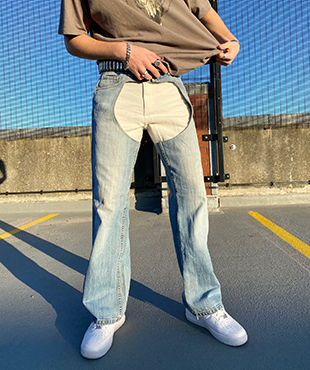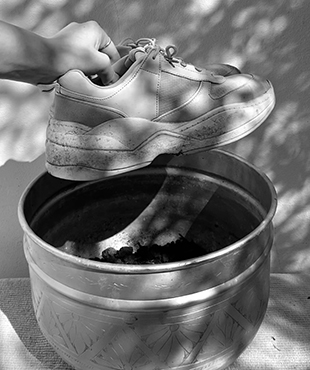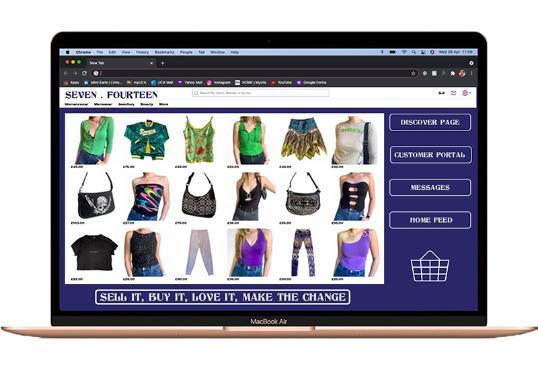Surrounded by more sustainable options than ever, all littered with overused buzz words ‘Sustainable’, ‘Eco’,‘Planet-friendly’, ‘Green’, the hard work falls to us as consumers to research and trust what we find because all too often these claims serve the product more than the planet.
In September 2021, there were over 55,400 new apparel and footwear items labelled with sustainability related descriptions retailing in the UK, the cheapest of these being a £2.40 T-shirt which was labelled as recycled, but at a closer look was organic cotton – no indication where from. The core of sustainability is ensuring longevity of resources. A quick check and balances of our present-day resources usage and we see that we are over-borrowing from future generations at a rate that we cannot pay back. When it comes to fashion, the elephant in the room is over consumption, we are making too much, too often. The mis-use of labelling and product descriptions just adds to this issue, making us believe we can keep buying and buying with no impact.
Naturally the fast fashion industry is less concerned with ‘how we consume less’, but waiting in the wings are the next generation of fashion creatives who are redefining fashion and its systems to tackle over consumption head-on. This September very few students started their first day on their fashion business degree unaware of the damaging impact of the global fashion industry. Much like our local communities and our global community; Awareness is growing, and it’s a fertile place to start.
If sustainable education is not built into the curriculum you are already behind the curve. We’re teaching them to re-wire an industry, so it’s imperative they learn how the industry currently works, alongside the social and environmental issues it causes. It’s like taking a red marker to their text-books, it’s very liberating. As time has passed this education has become increasingly foundational, and students are empowered to de-code the mis-leading marketing, and dig deeper into production, and supply chains across the fashion landscape by their own volition. Inevitably they become so well-informed, they are able to diagnose the core of the issue to be overconsumption, caused by a relentless pursuit of growth for brands, and an ability to contort consumer perception and wellbeing. Final year students will then spend the majority of their graduating year tackling this head-on in their projects.
Whilst many mainstream fashion brands are focussing on marketing sustainability, four 2021 graduates have been busy unpicking the root causes of overconsumption.

Workroom ©CJ Hammond
Making waste materials Work
CJ Hammond is one of these graduates who is taking a new approach to product design; starting with the tonnes of clothing that already exists, plus a high regard for honesty at the core of brand development. “From observing the fashion industry from an outside perspective, it’s faults were apparent and gave me more power to create a brand within this market that does not include those environmental issues.” His brand Workroom has been in steady development alongside his university degree; incorporating the education into this process. He says “In all of my [University] projects from beginning to end I always included eco-conscious ideas as a result of what I had learnt. At the core of Workroom is the consumer-brand relationship. by presenting our practises and being transparent. Our ethos lies within up-cycling unwanted materials or clothing and remaking them into new and exciting designs - giving a whole new life to the garment.” By working with the materials that already exist CJ is reducing a huge amount of resources and emissions wastage. According to wrap.org.uk 350,000 tonnes, that’s around £140 million worth of used but still wearable clothing goes to landfill in the UK every year.
CJ among many other graduates demonstrates an acute awareness of the marketing machine behind fast-fashion. “A huge amount of influencers are paid to promote cheap brands that are manufactured in ways that harms our environment. These brands are huge players in the ‘fast-fashion’ sector and sell products for ridiculously cheap prices encouraging consumers to keep purchasing.” says CJ. Another graduate Siân Lewis agrees, saying “Unfortunately, the fashion industry is particularly good at green washing, and it can be hard to find brands with strong environmental and ethical values. So, I try to avoid fast fashion as much as possible and instead look to invest in my wardrobe through purchasing high quality pieces that will last, plus supporting smaller businesses who use high quality materials, pay their employees fairly and treat their supply chain with respect.”

The Cloud Sneaker ©Siân Lewis
Designing out waste
Like CJ, Sián Lewis set her sights on confronting the issue of waste. Siân’s project focussed on a regenerative approach to product development; starting with design that takes full control of the end-of life of the garment. “That’s why I developed a plant-based, biodegradable sneaker brand that takes environment and ethics into consideration. With the average sneaker thrown into landfill and taking thousands of years to decompose, my sneaker will decay in just 20 years!”. Innovative textile solutions are a huge development area in the industry. Unfortunately, few brand’s go as far as Siân’s to capture that post-use phase, most brands opt to use recycled materials whilst still maintaining a linear approach, avoiding capturing the product at the end of its life. Most brands have zero research and development capacity which highlights the need for a collaborative approach between the science and engineering community, and industry. This would of course be an expensive undertaking and more financial support to elevate project’s like Siân’s, whilst at the same time imposing financial sanctions on over-producing brands would help to level the playing field. Siân is hopeful for a change and new-found value for ideas like hers, “COP26 is an opportunity to refocus our attention on the climate emergency, hold governments accountable, and push them to set real targets to reduce our carbon.”
Mary Carson, Senior Lecturer for Fashion Business who mentored the majority of these projects has seen first-hand the change in student mind-set over the past decade. “Our student’s interest in sustainability and the environmental impact of the fashion industry has grown hugely since 2015 with a really big shift in the last 3 years. The Greta effect from 2018 has been a huge driver for this – leading Gen Zers around the world as climate change activists. And, we have now reached a point where our students are no longer being taught sustainability because it has become second nature to them.”
The power of this generational shift is in part due to the acknowledgment that Gen Z and also Gen Alpha behind them are aware of the mammoth task being handed to their generation. This is not a legacy any generation wants to inherit.

Seven Fourteen ©Mimi Earle
Closing the value-action gap
Mimi Earle’s project is built on this new-found liberation to dismiss the fast-fashion industry and embrace the value of second-hand clothing. “Brands like Boohoo or Pretty Little Thing would fall tomorrow if they didn’t have student consumers.” Mimi’s observation highlights the large value-action gap between her generation’s belief system and their purchasing habits “Sustainability is talked about a lot with my generation, but fast fashion is still mostly bought by Gen Z and Gen Alpha and the constant cycle of trends plays a key role in continuing this practice.”
The importance of education in this area is clear to Mimi “Before university sustainability within the fashion industry wasn’t on my radar, but now it always directs my way of thinking, how I work, and has completely changed my lifestyle choices – deterring me from certain brands and seeing me buy and sell second-hand clothes.”. In Mimi’s work she understands the significance of accessible price-points, convenience and desire that drives the fast-fashion approach, and through her retail concept Seven Fourteen she demonstrates how to provide an alternative to fast-fashion through the second-hand clothing market. “My research shows that there is a gap in the sustainable fashion market for second-hand /pre-loved clothing. By using online resale platforms like Depop, Vinted or eBay we can challenge the dominance of fast-fashion brands and help create a more circular industry.”

And Ever ©Chanel Jordaan
Slowing down – the link between wellbeing and consumption
Chanél Jordaan developed an app for her project. “The climate emergency is by far the most important and pressing crisis of our time and Fashion can no longer continue as usual. The Gen Z are the most concerned and eco-conscious generation in history – we are the first generation to take it seriously – so fashion leaders need to step up and solve not just overproduction but overconsumption.” The app empowers the consumer to rethink their purchasing habits through the encouragement of wellbeing practices. “My work promotes a slower, more considerate and meaningful lifestyle. Being sustainable is not something to be bought, but rather it is in our being. I explore simple ways to live resourcefully or have a sustainable relationship with fashion without having to spend.” This recognition of connection, and the support to cultivate self-worth, and self-love really gets to the heart of the overconsumption issue and resonates with CJ’s viewpoints on influencer marketing. The need to fill our wardrobes, and have a new outfit for each night-out is a huge red-flag that consumers are reliant on materialism to bolster their identity.
By getting to the heart of the issue Chanél feels more empowered than ever “It's easy to feel deflated and powerless and like we aren’t making a difference, but we do have power as consumers, to know that with each action we are casting a vote for the type of world we want to live in.”
It’s clear the industry has a way to go in affecting change, but heartening to see a new generation of creatives willing to tackle the hard questions, and ensure their solutions go beyond marketing, and clever branding. As a micro-community these fashion business students demonstrate how education can be layered onto awareness to ignite change. It unveils the opportunity to scale this approach to our global communities. If consumers are provided the education to further their awareness, this kick-starts the power to question false narratives, and search out genuine agents of change.
“I hope that COP26 will be a beacon for raising global awareness of sustainability – this summit could be one of the last chances to stop or slow down the deterioration of our planet.” Mimi Earle.
Words by Fran Sheldon, Lecturer Fashion Trend Forecasting and Sustainability at UCA
Kick start your career in Fashion and Business by checking out our course pages
/prod01/channel_8/media/marketing-media/news/news-2021/and-ever-Chanel-Jordaan-web.jpg)